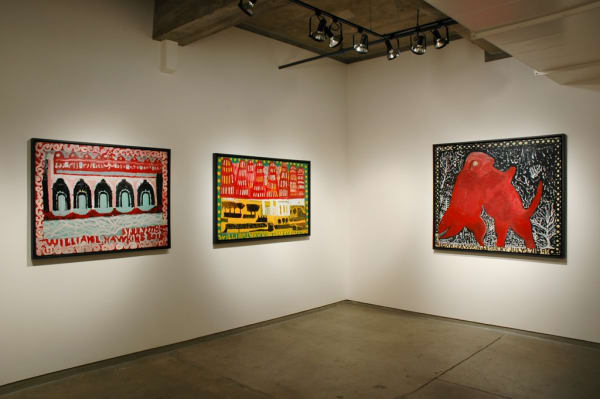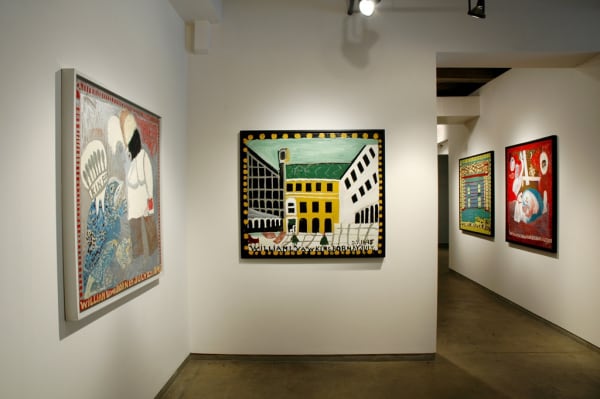William Hawkins: Making Itself
Ricco/Maresca Gallery presents “William Hawkins: Making Itself” an exhibition of work by one of the most audacious painters of the twentieth century. William Hawkins (1895-1990) died just short of his 95th birthday, leaving behind nearly 400 bold, expressive paintings of animals, landscapes, and architectural icons. The self-taught African-American artist is renown for daring to take painting to an extreme level — letting the painting take over the process. Hawkins gave the world the uninhibited expression of his gift, intuitively combining an outrageous palette suggestive of 1960s Pop Art with wild geometric abstracted forms. He created his paintings with inexpensive and readily available materials — oil enamel and a single brush on Masonite, a surface he preferred because it didn’t “suck-up the paint.” Often he would pour or drip the paint onto the surface, then lift and tilt the board, letting gravity play out the painting’s composition. As Hawkins so often said, he was just watching the painting “making itself.”
William Hawkins was born in Kentucky on July 27,1895; his big block letter signature informs us of this in nearly all of his paintings. In 1916 he moved to Columbus, Ohio where he became an urban jack-of-all-trades, working relentlessly and often simultaneously at numerous odd jobs including driving a truck. Although Columbus became Hawkins’ permanent home, his childhood in Kentucky provided him with his knowledge and love of animals, an awareness that informs even his most fantastic dinosaur and safari animal paintings. And, in the 1930s, when he began making art, animals were his first subjects. In Two Dinosaurs Wrestling Hawkins intuits the mass and force of the creatures, and physically builds out their forms with sand. Although he only had a third grade education, Hawkins always retained a curious, optimistic and energetic spirit. His selective eye constantly culled photos from newspapers, magazines, and advertisements, which he would clip and store in a suitcase “archive.” He referred to these images as “research.” Almost all of his paintings originated from one of these clippings, such as the swimming pool at the Hearst Castle in Neptune Pool, San Simeon or the Columbus, Ohio landmark depicted in his series of paintings of the Deshler Hotel. Hawkins would also collage photos into his paintings and paint around the collaged element, adding another dimension to the painting’s formal composition and its emotional power.
Even though Hawkins had dedicated himself exclusively to his art by 1979, his work wasn’t exhibited publicly until 1982 when artist Lee Garrett entered one of Hawkins’ paintings in the amateur division of the Ohio State Fair. However, artist Robert Natkin was so profoundly affected by Hawkins’ painting that he emphatically awarded it first prize in the professional division. William Hawkins’ prominence in the history of art was thereby established, and his career rapidly gained momentum. He painted with uninhibited exuberance up until his death from a stroke in 1990. Always open to experimentation and growth as an artist, Hawkins said,”There’s nothing to do but sit around and get better.”
William Hawkins has been the subject of museum retrospectives at the American Museum of Folk Art, New York, the Columbus Museum of Art, and the Ginza Art Space, Shiseido Corporation, Tokyo. His paintings and drawings have been exhibited in major museum survey exhibitions of American Outsider and Folk Art including the New Orleans Museum of Art, the Philadelphia Museum of Art, The National Museum of American Art, Washington, D.C., and the High Museum of Art, Atlanta, GA among many others. His work is in preeminent museum and private collections throughout the world, including the American Museum of Folk Art, New York, the Columbus Museum of Art, the High Museum of Art, The National Museum of American Art, Setagaya Art Museum, Tokyo and the Newark Museum, New Jersey among others. Most recently, the Intuit Center for Intuitive and Outsider Art, Chicago, IL showcased William Hawkins alongside Hawkins Bolden in “Hawkins/Hawkins: One Saw Everything, One Saw Nothing” (September 14, 2012 – January 5, 2013).
William Hawkins: Making Itself will be on view at Ricco/Maresca Gallery from March 21st through May 11, 2013.







